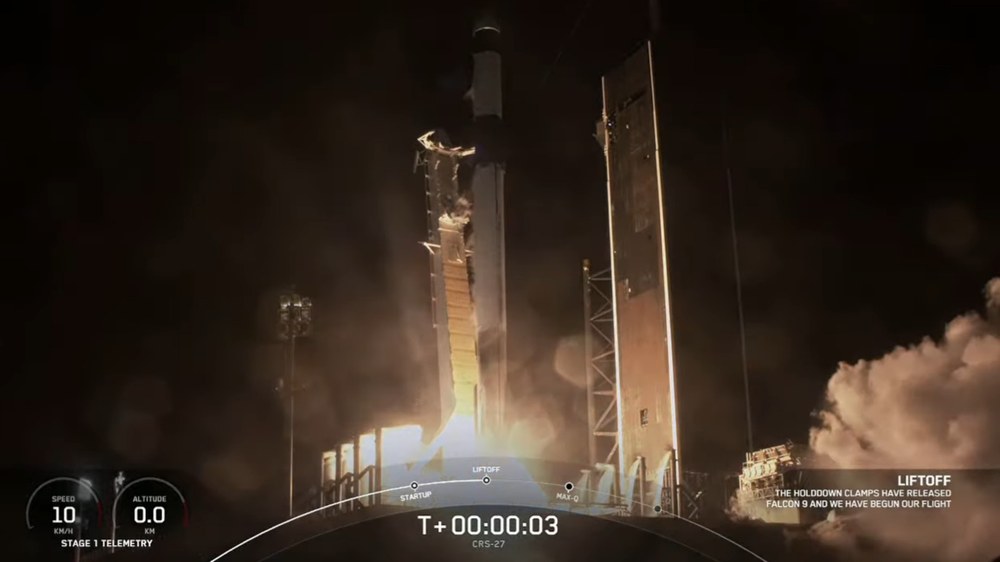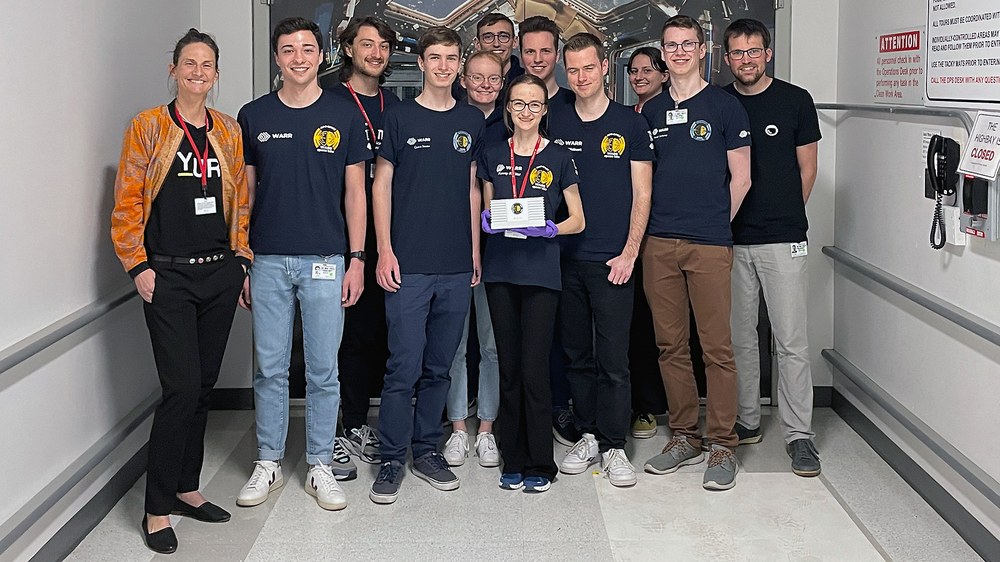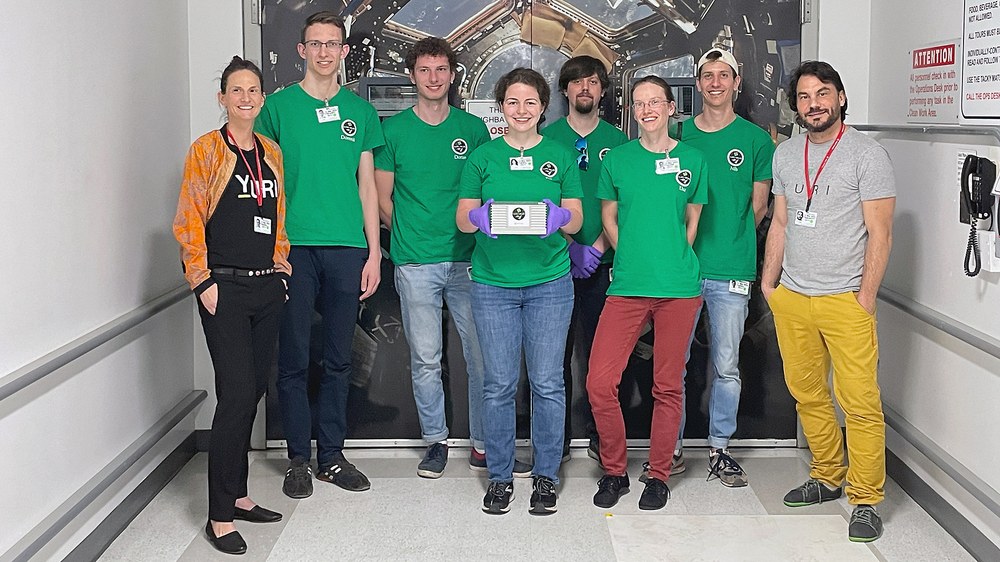Student experiments on their way to the ISS



- On 15 March 2023, the experiments of the four winning teams from the universities in Munich, Stuttgart, Hanover and Esch-Belval (Luxembourg) will be launched to the International Space Station ISS.
- The students are researching neurons, plant symbioses and novel space technologies.
- The teams each received 20,000 euros in funding from the German Space Agency at DLR and the Luxembourg Space Agency (LSA) and now have 30 days to conduct research on the ISS.
- Focus: Spaceflight, promotion of young scientists
+++ On Wednesday, 15 March 2023 at 01:30 CET (14 March at 20:30 local time), the 27th Commercial Resupply Service (CRS-27) mission lifted off from Launch Complex 39A (LC-39A) at NASA's Kennedy Space Center in Florida. The Falcon 9 rocket of the US space company SpaceX is also carrying the four experiments of the Überflieger 2 competition of the German Space Agency at DLR and the Luxembourg Space Agency (LSA). After stage separation, the first stage of the Falcon 9 landed on the droneship 'A Shortfall of Gravitas' in the Atlantic Ocean. On Thursday 16 March, Dragon autonomously docked with the International Space Station ISS.+++
It has been just one and a half years since the German Space Agency at the German Aerospace Center (Deutsches Zentrum für Luft- und Raumfahrt; DLR) and the Luxembourg Space Agency (LSA) gave the green light for the 'Überflieger 2' competition. From 23 August to 15 October 2021, both space agencies called on students to submit ideas for their experiments on the International Space Station ISS. After the announcement of the winners on 2 December 2021, the teams were given one year to develop and build their technology and prepare it for a flight to space. On 15 March 2023, the winning experiments will lift off from Cape Canaveral in Florida to the ISS on board a Falcon 9 rocket of the US space company SpaceX.
"We are very pleased to have been able to get four ambitious experiments by dedicated students from Germany and Luxembourg on their way to the ISS in such a short time in cooperation with our colleagues from our neighbouring country. With 'Überflieger 2', we support young researchers in close cross-border cooperation and show that spaceflight can also be carried out quickly and that it is not a question of gender because all the teams are led by women," emphasises Walther Pelzer, DLR Executive Board Member and Director General of the German Space Agency at DLR. On board the rocket are 'ADDONISS' from the TU Munich, 'BRAINS' from the University of Luxembourg, 'FARGO' from the University of Stuttgart and 'Glücksklee' from Leibniz University Hannover.
Überflieger 2 – young teams manage their own space mission
The winners first had to form an interdisciplinary team of students from a wide range of disciplines to cover all scientific, technical and organisational aspects of experiment development and thus be able to both develop and build their experiment as well as handle project management and qualification for space. They were supported by yuri GmbH – a German space start-up from Meckenbeuren (Baden-Württemberg). "A year of exciting work now lies behind the teams. They had to manage a complete space mission themselves in addition to their studies. That is a great achievement and requires excellent teamwork.
The next challenges are the flight to the ISS and running the experiments. We are already looking forward to the results," says Julianna Schmitz, project manager of the 'Überflieger 2' competition at the German Space Agency at DLR. When the experiments arrive at the ISS in their 10 x 10 x 20-centimetre containers, they will be received by NASA astronauts Warren 'Woody' Hoburg and Frank Rubio, and installed in the TangoLab in the US Destiny module.
For 30 days, they will run there fully automatically – in other words, without astronautical assistance. However, program changes are possible through commands that the teams can transmit to the operating company SpaceTango. The teams will also receive the experiment data from the operating company. After the end of the operating period, the experiments will be uninstalled and returned to Earth in the Dragon capsule CRS-27 in April 2023.
ADDONISS – Brain research under space conditions
People in space appear to experience the effects of aging faster than people on Earth. This has been shown by previous research on the ISS. "We now want to make use of these conditions on the space station to investigate neurodegenerative disorders – such as Alzheimer's disease – with our experiment. To do this, we will try to measure electrical signals from neuronal cell cultures under the environmental conditions there," explains Selina Kanamüller from the WARR Space Labs team at TU Munich describing her experiment ADDONISS (Ageing and Degenerative Diseases of Neurons on the ISS).
Half of the cultures are treated with an agent that causes similar metabolic disorders as Alzheimer's disease. The cell cultures grow directly on a microchip that can measure electrical signals and thus the activity of the cells. At the same time, the growth of the cells is also observed through a miniaturised camera microscope. "The results will then be compared with experiments on the ground and thus, hopefully, our space results will help to advance Alzheimer's research on Earth," says Kanamüller.
BRAINS – Studying cell growth in microgravity
As part of the BRAINS project, the growth of 3D cell culture systems, called organoids, is being studied under microgravity conditions on board the ISS. Research groups are currently trying to mimic the human midbrain as closely as possible with the help of organoids. When cultivated in the laboratory, the cells are more densely packed, and their size is usually limited to a diameter of two to three millimetres. This limits their spatial organisation and the diversity of cell populations.
"We want to take advantage of the environmental conditions on the space station and study the 3D cell organisation of organoids. We hope to obtain larger and less densely packed organoids that more closely mimic the human physiological brain," explains Elisa Zuccoli from the BRAINS (Biological Research using Artificial Intelligence for Neuroscience in Space) team from the University of Luxembourg. After 30 days on the ISS, the team will use artificial intelligence to analyse image features to compare their results with the current experiments on the ground. They believe that the growth of midbrain organoids under microgravity conditions could have a major impact on the future pharmaceutical industry and regenerative medicine.
FARGO – Components for the space travel of tomorrow
The PAPELL (Pump Application using Pulsed Electromagnets for Liquid relocation) experiment flew to the ISS during the first High-flyers competition in 2018. Now the student association KSat e.V. team from the University of Stuttgart is participating for the second time. "With our new experiment, we are bringing three applications of ferrofluids to the space station to study the reaction of their magnetic particles to magnetic fields under the environmental conditions there. For example, we are testing a thermal fluid switch that regulates the heat transfer between two components and an electrical one designed to close and open a circuit. We are also testing a novel system in which we want to take over the attitude control of small satellites by using ferrofluids," explains Nicolas Heinz from the FARGO (Ferrofluid Application Research Goes Orbital) team. All three applications share the common feature of dispensing mechanical parts as far as possible to significantly reduce the risk of failure due to wear and tear. Currently, the experiment is investigating the extent to which the three concepts work in microgravity so that they can be used in future space missions.
Glücksklee – Plant growth on the ISS under the microscope
Future long-term missions in space will also require astronaut crews to become self-sufficient and be able to grow plants as a food source in the spacecraft. "However, the altered gravity during such missions affects plant growth. Therefore, we want to investigate the changes in the symbiotic relationship between clover (Medicago truncatula) and soil-dwelling bacteria (Sinorhizobium melilot) in microgravity conditions on the space station", explains Pia Bensch from the Glücksklee team at Leibniz University Hannover.
On the ground, the bacteria form nodules in the roots of the clover. In the process, they receive nutrients from the plant and pass nitrogen on to it, which the plant needs to grow. But how does this cycle work under these extreme conditions? To answer this question, several clover seedlings will grow under controlled conditions in the experiment container. During their stay on the ISS, a camera will observe their growth. After returning to Earth, the 'space clover' will be thoroughly examined genetically in the laboratory for gravity-induced changes.
The German Physical Society (DPG) supported 'Überflieger 2' in selecting the experiments and promoting the project. The technical implementation is being carried out by the company yuri GmbH. The German contribution of 'Überflieger 2' is financed with funds from the Federal Ministry for Economic Affairs and Climate Action (BMWK).
